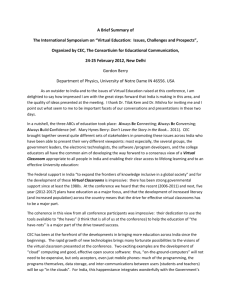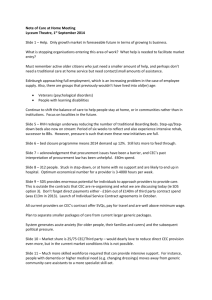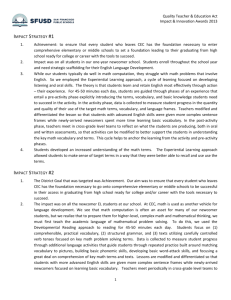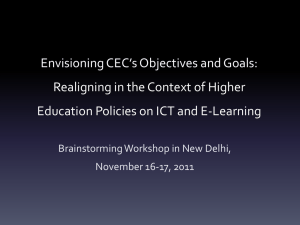Slides. - Computer Science
advertisement
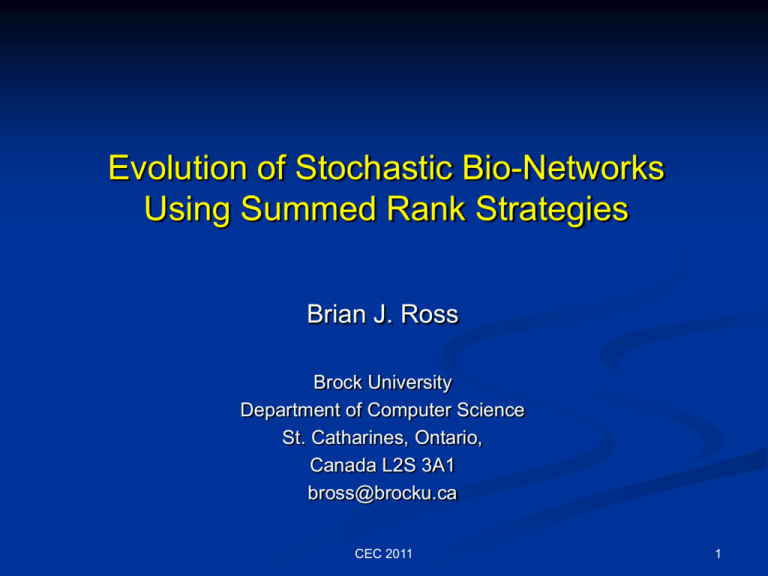
Evolution of Stochastic Bio-Networks Using Summed Rank Strategies Brian J. Ross Brock University Department of Computer Science St. Catharines, Ontario, Canada L2S 3A1 bross@brocku.ca CEC 2011 1 Outline Problem overview Background Experiment design Results Conclusions CEC 2011 2 Bio-network Modeling Systems biology: model bio-chemical reactions Purposes: simulation, analysis uses mathematical and computer modeling Formalisms include: Petri Nets [Baldan 2010] Bayesian networks [Friedman et al. 2000] P-systems [Perez-Jiminez & Romero-Campero 2006] cellular automata [Deutsch & Dormann 2005] ODEs [Schwartz 2008] Process algebra [Blossey et al. 2006, Regev et al. 2004] CEC 2011 3 EC and Bio-networks Petri nets [Kitagawa & Iba 2003, Moore & Hahn 2004] S-systems [Wang et al. 2007] ODE [Floares 2008, Qian et al. 2008] Metabolic networks as circuits [Koza et al. 2000] Process algebra SPI calculus [Ross & Imada 2009, 2010] PEPA [Marco, Cairns & Shankland 2011] SPI – gene gates [Imada 2009] SPI – PIM [Ross 2011] Related work: GP/GA and noisy time series [Borrelli et al. 2006, Jin and Branke 2005, Rodriquez-Vazquez & Fleming 2005, Zhang et al. 2004] CEC 2011 4 Stochastic pi-calculus (SPI) A process algebra that denotes: Features useful for bio-network modeling: stochastic simulation: characterizes noise, chaotic signals compositional: complex systems arise from combinations of smaller processes Characteristics: concurrency stochastic modeling: simulation and analyses mobility (dynamic network changes... but not examined here) Concise denotation of complex behaviours. Has “programming language” characteristics. Issues: unintuitive, sharp learning curve arcane: recommended to have a background in formal methods research CEC 2011 5 Evolving SPI calculus models Use genetic programming to evolve SPI models Some simple models successfully reverse engineered. Grammar-guided GP constrains SPI models explored. Statistical features characterize process behaviours: [Ross & Imada 2009, 2010] required because of noisy, stochastic behaviours compare to deterministic processes: compare sum of errors between candidate and target processes 2010 paper: used MOP with Pareto on the feature test Issues: Some simple cases defied exact solutions. But lots of close calls. Pareto ranking results in outliers: one objective is very good, but majority are poor considered an undominated solution, even though it is useless CEC 2011 6 Goals Re-examine use of GP to synthesize SPI models. See if an alternative multi-objective scoring strategy may help: sum of ranks. proposed by Bentley & Wakefield (1997) for high-dimensional MOP evolution Also useful for low- to moderate dimension MOP problems Main advantages: discourages outliers solutions are stronger on majority of objectives parameterless: no need for niche dimensions, etc. Variation: sum of dominance ranks [Bergen & Ross 2010, Flack 2010, Coia & Ross 2011] dominance: # individuals that are superior Can include weights too. CEC 2011 7 Sum of Ranks Fitness vector Pareto rank Rank vector Sum Rank Normalized Sum Rank ( 1, 9, 5, 4) 1 (2, 1, 2, 2) 7 1 1.47 1 ( 2, 100, 4, 8) 1 (3, 2, 1, 3) 9 2 2.03 2 (10, 9, 9, 10) 2 (4, 1, 4, 4) 13 4 2.6 5 ( 16, 100, 8, 4) 2 (5, 2, 3, 2) 12 3 2.56 4 9, 500, 0) 1 (5, 1, 5, 1) 12 3 2.37 3 ( 0, 1000, 1000, 1000) 1 (1, 3, 6, 5) 15 5 3.2 6 (16, Note: (0,1000, 1000, 1000) is an outlier. Outliers can quickly obtain preferable Pareto scores! CEC 2011 8 SPI calculus [Priami 1995] # : concurrent execution . : sequential exec + : stochastic choice in(c), out(c) : atomic action delay(t) : stochastic delay handshake: in(x).P # out(x).Q → P # Q when multiple active terms available for handshaking, they are selected stochastically via Gillespie algorithm CEC 2011 9 SPI calculus: context free grammar Grammar-guided GP: DCTG-GP Prolog-based DCTG: define syntax and semantics in one framework syntactic, knowledge-based constraints easy to introduce exploration of more sensible areas of search space CEC 2011 10 Feature analyses Time series: highly studied phenomena modeling prediction eg. financial prediction, weather forecasting,... Imada (2009) used statistical features to characterize stochastic process behaviours based on those in [Nanopoulos et al 2001; Wang et al. 2006] stochastic, noisy behaviours can be reasonably characterized The general problem is intractable: time series for Turing machine states. CEC 2011 11 Features selectively used here μ: mean σ: standard deviation Kurtosis: peakness wrt normal distribution Serial correlation (sc): fit to white noise model Chaos: sensitivity on initial values Teravirta: degree on non-linearity Adjusted frequency: cyclic activity of possibly varying frequency CEC 2011 12 Dealing with stochastic processes One process may produce different behaviours... Feature scores will vary accordingly: fitness noise. Might perform multiple interpretations per fitness evaluation. How to identify a solution from a run? “Best” score may be accidentally good. A higher quality solution might have a worse score, due to statistical chance. CEC 2011 13 Obtaining target behaviours 1. Target SPI model simulated 1000 times. 2. Mean and standard deviation for all feature values determined. 3. Candidate features selected: a) Stability(z-score): b) Select features based on stability, and perceived value of that feature for target behaviour of interest. Note: Some features may be more stable than others. This does not necessarily mean they are descriptively valuable. CEC 2011 14 1. Lotka-Volterra Dynamic model of predator-prey equilibrium CEC 2011 15 2. Repressilator Autocatalytic reaction with noisy oscillating behaviour CEC 2011 16 3. Oregonator Another autocatalytic reaction CEC 2011 17 SPI parameters Parameter Lotka-Volterra MOP strategy Sum dominance Sum ranks Sum ranks (norm) Rank weights (def 1) no w(freq) = 3 w(freq) = 2 Stream filter 50 3 25 Max time 5.0 200,000 3.5 Max ticks 400,000 20,000 250,000 yes yes no Log delays Repressilator CEC 2011 Oregonator 18 GP Parameters Parameter Value Runs 20 Solutions per run 25 Initial population size 4,000 Population size 1,500 Unique population Yes Max tree depth (init) 8 Max tree depth 12 Probability crossover 90% Probability internal crossover 85% Probability terminal mutation 75% CEC 2011 19 Results Total: 500 solutions per experiment (20 runs each) Exact solution is syntactic match with target model. All behavioural matches turned out to be syntactic matches. CEC 2011 20 Results: feature matches Each candidate solution interpreted 100 times. z-score match of feature at 95% significance is a “hit” Oregonator has 15 features in total CEC 2011 21 Error plot: Lotka-Volterra (avg best) CEC 2011 22 Error plots: Lotka-Volterra (avg popn) CEC 2011 23 Error plot: Oregonator (avg best) CEC 2011 24 Error plot: Oregonator (avg popn) CEC 2011 25 One Oregonator solution CEC 2011 26 Results Good results for Lotka-Volterra and Repressilator. Behavioural matches = syntactic matches with target. Fortuitous selection of features for these processes. Unsuccessful for Oregonator. Reasons may include... 1. Inappropriate feature selections. 2. Excessive number of features and channels. 3. Simulation time was too short. Could not capture oscillation easily. 4. Need further refined constraints in CFG, to manage complex search space. CEC 2011 27 Conclusions Best results so far using GP to evolve models in raw SPI calculus. SPI calculus is a challenging language for GP. summed rank variations shown to be superior to Pareto ranking [Ross & Imada 2010], statistical weighting [Ross & Imada 2009] Not well behaved during evolution: lots of non-functional expressions. But challenges are gifts! Future work: scaling upwards... 1. Feature selection strategies. 2. More effective grammatical constraints for SPI calculus. 3. Higher-level modeling languages: gene gates, PIM, BlenX, etc CEC 2011 28


